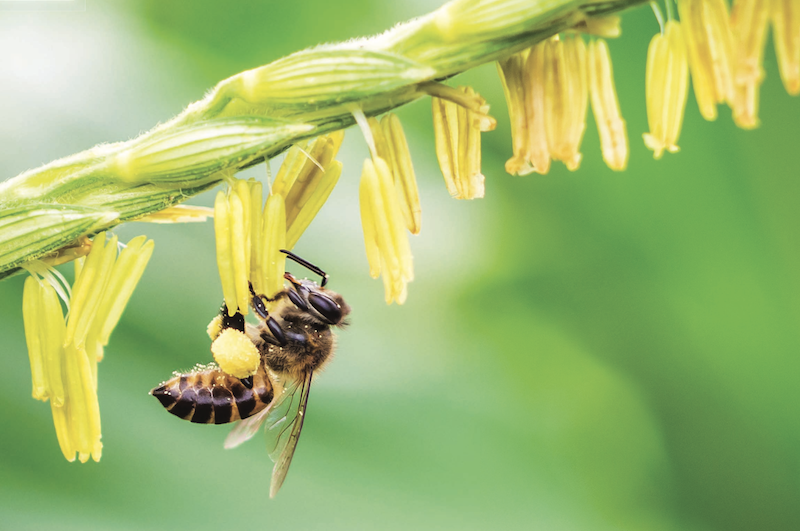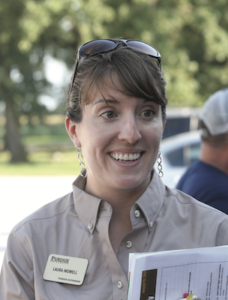
Mar 3, 2022
Pollination by bees on farm is impacted by what they find elsewhere
Bees forage far from the crops in the field, and new research from Purdue University confirms how dominant this broad range of foraging is in bees’ diet.
“Where do bees in a commercial cucumber field collect the most pollen?” asked Laura Ingwell, assistant professor in Purdue University’s Department of Entomology.
It’s not from the cucumbers. Cucumber pollen only makes up 1-2% of the bees’ diet. Pollen from sumac, corn and goldenrod are more predominant, and the proportion of pollen collected from each varies over the season.
Ingwell and Elizabeth Long, another assistant professor in Purdue’s entomology department, spoke on pollinators at the 2021 Indiana Hort Congress and Expo, which was held virtually.
In a study conducted by Michigan State University (MSU) and Purdue, sumac contributed two-thirds of the pollen collected by honeybee colonies in late June. Corn and goldenrod contributed hardly any pollen at this time of the year. The rest of the pollen collected by the honeybees came from other sources.
By mid-July, the contribution from sumac had declined to about 20% of the bees’ diet, and corn had increased to about 10%. By the end of July, the contribution from corn – since it was tasseling – had increased to nearly two-thirds of the bees’ diet, while sumac’s contribution gradually declined to about 10%.
The percentage of pollen collected by honeybees while foraging in corn and sumac declined in August, and the amount contributed by goldenrod accelerated until it was contributing two-thirds of the pollen in early September.

“We have these spikes of exposure,” Ingwell said, and these high points of exposure change over the growing season.
“There are interactions of multiple factors,” Long said. “Herbicides can kill weeds the bees may need as a pollen source.”
These foraging exposures do not minimize the concerns about pollinator exposure in the cucurbit fields where pollinators encounter higher concentrations of pesticides and more frequent pesticide applications. Most cucurbits require 10-20 pollinator visits per flower for fruit set, and even one gram of contaminated pollen can be fatal to a pollinator.
“Conserving pollinators in specialty crops requires a systems approach,” Ingwell said, that considers all sources of pesticide exposure.
The type of pesticide matters. Herbicides are generally less harmful to bees than fungicides. Fungicides are generally less harmful than insecticides, although certain fungicides and insecticides can become more toxic when mixed.
Adjuvants can be harmful, too.
The mode of action matters. Some insecticides are fast acting, contact products and some have to be ingested and work more slowly. Some – like the neonicotinoids – are systemic; some aren’t. The degree of residual activity also varies.
Seed treatments, soil drenches and foliar applications all carry different risks to pollinators. Select
the application type and timing that minimizes those risks.
An integrated pest management (IPM) program of pest monitoring can help with all of this.
There is an economic treatment threshold for striped cucumber beetles in cucumbers.
“We can tolerate five beetles per plant,” Ingwell said.
Saving one insecticide application with IPM will more than pay for the cost of scouting and soften the impact on pollinators.
Cultural controls like delaying planting to avoid the damaging life stage of the pest, or excluding pests with netting or row covers, can also help, as can the strategic planning of pesticide applications. This includes minimizing drift and applying in the evening when flowers are closed and fewer bees are foraging. Using the lowest possible pesticide rate that is effective against the target pest also minimizes pollinator exposure.
Maintaining untreated strips in fields gives pollinators a refuge. “Make sure the pollinator strips don’t come in contact with pesticides,” Long said.
All insecticides with some toxicity to pollinators have pollinator warning boxes on the label, and the boxes have specific instructions for minimizing pollinator risk. It’s important to choose products that are safe for bees in the target crop, and any other nearby crops in which the bees may forage.
“Scouting plays an important role in all of our cropping systems,” Ingwell said, “and pollinator-friendly pesticide use needs to be considered beyond the pollinator-dependent crop.”






